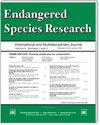Ecology, natural history, and conservation status of Scolopendra abnormis, a threatened centipede endemic to Mauritius
IF 2.9
2区 环境科学与生态学
Q2 BIODIVERSITY CONSERVATION
引用次数: 0
Abstract
ABSTRACT: The Serpent Island centipede Scolopendra abnormis is a threatened centipede species found on only 2 small islands in the Indian Ocean: Round Island, located 22.5 km northeast of Mauritius, and Serpent Island, 4 km northwest of Round Island. Current understanding of its ecology is based on limited direct observations from 30 yr ago. Round Island has since undergone significant habitat restoration. Hyperabundant non-native ants are also present, which may impact centipede nesting behaviour, ecology, and survival. Recent methodological advances, such as high-throughput sequencing of dietary DNA, can extend our understanding of invertebrate ecology and provide data complementary to direct observation. Using a combination of dietary metabarcoding and observational approaches, we provide new insights into the ecology and natural history of this threatened invertebrate predator. S. abnormis nest most consistently in the root network found beneath endemic Pandanus vandermeeschii trees. They are also found in areas with good soil cover, herbaceous growth, and areas of bare rock slab. Only 4 of 43 centipedes in this study were found near an ant foraging trail, which may have significant implications for S. abnormis nesting habits. These centipedes primarily consume insect prey (particularly taxa within Lepidoptera, Hymenoptera, Diptera), irrespective of centipede body size. A quarter of centipedes also consumed endemic lizards. We also found marked differences in diet composition between wet and dry seasons arising from the changing availability of prey. We provide additional natural history observations and conclude by suggesting conservation actions that would help better understand and safeguard S. abnormis populations.毛里求斯特有的濒危蜈蚣 Scolopendra abnormis 的生态学、自然史和保护现状
摘要:蛇岛蜈蚣(Scolopendra abnormis)是一种濒危蜈蚣物种,仅分布在印度洋的两个小岛上:圆岛位于毛里求斯东北 22.5 公里处,蛇岛位于圆岛西北 4 公里处。目前对其生态的了解是基于 30 年前的有限直接观察。此后,圆岛的栖息地进行了重大修复。岛上还有大量非本地蚂蚁,这可能会影响蜈蚣的筑巢行为、生态和生存。最近方法学的进步,如饮食 DNA 的高通量测序,可以扩展我们对无脊椎动物生态学的了解,并提供与直接观察相辅相成的数据。我们结合食物代谢编码和观察方法,对这种濒危无脊椎动物捕食者的生态学和自然史提供了新的见解。异常蝠最常筑巢于当地特有的山竹树(Pandanus vandermeeschii)下的根网中。在土壤覆盖良好、长有草本植物和裸露岩板的区域也能发现它们的踪迹。在这项研究的 43 条蜈蚣中,只有 4 条是在蚂蚁觅食踪迹附近发现的,这可能对异常蜈蚣的筑巢习性有重要影响。这些蜈蚣主要捕食昆虫猎物(尤其是鳞翅目、膜翅目和双翅目中的分类群),与蜈蚣的体型大小无关。四分之一的蜈蚣还捕食当地特有的蜥蜴。我们还发现,由于猎物数量的变化,蜈蚣的食物组成在雨季和旱季之间存在明显差异。我们还提供了更多的自然史观察结果,最后提出了保护行动建议,以帮助更好地了解和保护异常棘蜥种群。
本文章由计算机程序翻译,如有差异,请以英文原文为准。
求助全文
约1分钟内获得全文
求助全文
来源期刊

Endangered Species Research
BIODIVERSITY CONSERVATION-
CiteScore
5.50
自引率
6.50%
发文量
38
审稿时长
31 weeks
期刊介绍:
ESR is international and interdisciplinary. It covers all endangered forms of life on Earth, the threats faced by species and their habitats and the necessary steps that must be undertaken to ensure their conservation. ESR publishes high quality contributions reporting research on all species (and habitats) of conservation concern, whether they be classified as Near Threatened or Threatened (Endangered or Vulnerable) by the International Union for the Conservation of Nature and Natural Resources (IUCN) or highlighted as part of national or regional conservation strategies. Submissions on all aspects of conservation science are welcome.
 求助内容:
求助内容: 应助结果提醒方式:
应助结果提醒方式:


